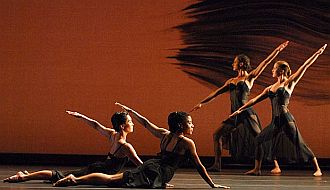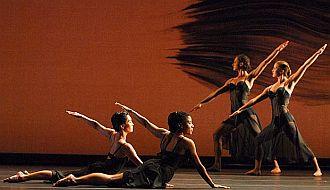
Why these three pieces?
I was looking for something I didn’t know very well.Why did you want something you didn’t know very well?
Because people are very lazy when it comes to listening to Mozart. They don’t have to hear the same pieces over and over again, gorgeous as they are. People don’t need to hear the Jupiter Symphony again. I could have easily made something to that, or to the theme to Elvira Madigan. This way, you have to actually listen, instead of knowing how it’s fulfilled and whether it works against or according to your expectations.When Mozart Dances premiered last year at Lincoln Center’s Mostly Mozart Festival, Emanuel Ax was the pianist. How do things change when you have a different virtuoso, Garrick Ohlsson, at the keyboard, and a different conductor and orchestra?
I’ve never worked with Garrick, so I don’t know. We work with different musicians all the time. That’s why I don’t rehearse with recorded music. We always have live music in the studio. I choreographed it with a pianist in the room, so when Manny Ax came in, we were mostly ready. I worked out the tempi, but it’s very different from one player to another. It’s fun and interesting.What other Mozart have you done?
Fantasy and Fugue. I choreographed Idomeneo for Glyndebourne. I staged a production of The Marriage of Figaro.I read a few reviews of Mozart Dances and one of them said it was startling that the dancers moved in direct contrast to the music, that they went back on their heels, that they looked as if they were earthbound, instead of looking as light and lyrical as the music.
[Are you asking] what does that mean? Why would I want to do what everyone will imagine would happen? That’s what Peter Martins [a choreographer and artistic director of the New York City Ballet] is for. And you may quote me. I don’t discuss what reviewers say. What they do is another job, and some of them are very good at it. But there would be no dance criticism without choreographers. I’ve heard people say, “I like everything but the ending.” I don’t tell them, “When I was making this dance, I did a bunch of endings, including the dumb one you preferred.” From others, it’s — of course — “There he goes again. He slavishly follows the music, note for note.” Oh, really? I don’t know what that means! If you were a classical Indian dancer and you didn’t follow the tune, it would be, “What the hell are you doing?”So how do you think Mozart Dances will fare in Berkeley?
I’ve known Garrick slightly for years and am very excited to be doing it with him. I did it with Ursula Oppens in Chicago, and also with other conductors and orchestras. They all fall within a certain range of tempo and interpretation. If you go crazy, you’re not really playing it right. Musicians like me, because I know music. I’m not really bending it out of shape.
What happens when the company gets here?
We rehearse a day and a half in Berkeley. My first day is the rehearsal of the sonata. Then we do the orchestral work. There are separate calls; the orchestra is there, or not. And we have to rearrange the pit and move everything around twice.What do you think of the conductor?
Jane Glover’s great. She did King Arthur. She was schoolmates at Oxford with [Nicholas] McGegan. She lives in London and works a great deal in Chicago. And she wrote this fabulous book, Mozart’s Women, about the women in his life and in his operas.How do you teach the musical nuances to the dancers?
I point things out that are interesting or important, and they learn the piece bar by bar, as I’m choreographing it, so they learn it thoroughly. It’s a normal part of who they are and what they do.Do most dancers understand music and rhythm and so on?
Most dancers don’t have a f------ clue about music. A lot have terrible rhythm. In a lot of the classical ballet industry, you’re just using big, broad strokes of music. It’s a vagary that really bothers me, actually. That’s another reason not to use familiar music. And I’m not damning dancers: They’re not prepared for that, they’re not trained for that.What’s coming up?
I’m choreographing Romeo and Juliet by Prokofiev, using the original manuscript, which has never been performed. So it’s a world premiere of the score, in July at Bard College. We’ll be bringing it to Cal Performances, definitely. I don’t know when. And I’m doing a piece for San Francisco Ballet to a commissioned score by John Adams.So when you’re choreographing, are you thinking about the composer and what he might have been thinking of when he composed whatever piece you’re working with?
No, not at all.What are you thinking about when you’re choreographing?
Nobody’s ever asked me that.Is it a dumb question?
No, it’s a great question. I just never thought about it. I figure stuff out. I study the music and make up dances. I figure out what’s next, and how to make it look gorgeous, how to make it satisfying and surprising.
